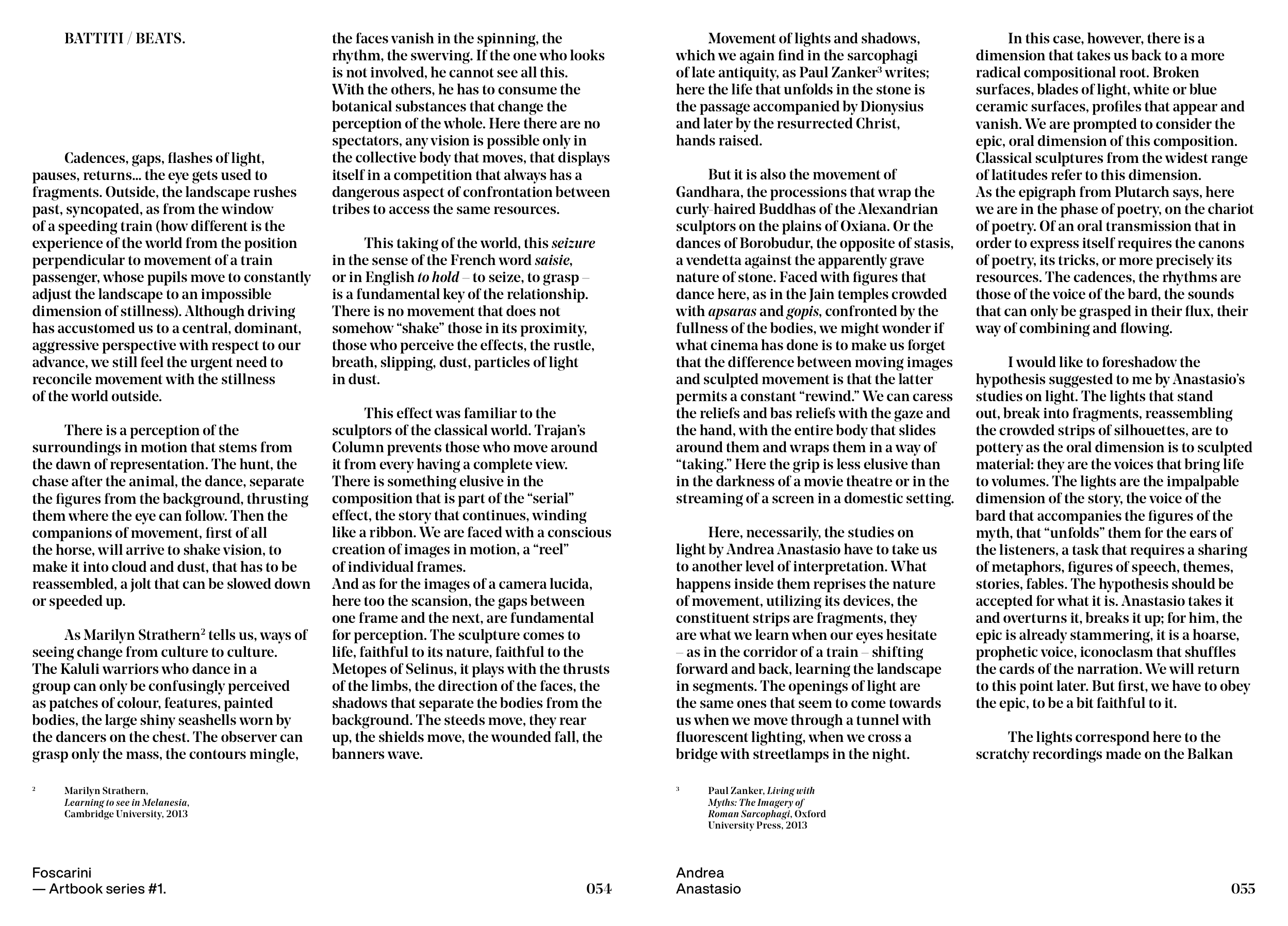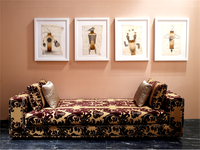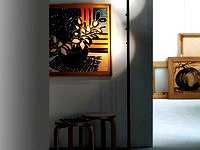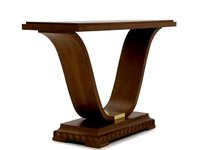Foscarini
— Artbook series #1.
Andrea
Anastasio
054
055
2
Marilyn Strathern,
Learning to see in Melanesia,
Cambridge University, 2013
3
Paul Zanker, Living with
Myths: The Imagery of
Roman Sarcophagi, Oxford
University Press, 2013
Cadences, gaps, flashes of light,
pauses, returns… the eye gets used to
fragments. Outside, the landscape rushes
past, syncopated, as from the window
of a speeding train (how different is the
experience of the world from the position
perpendicular to movement of a train
passenger, whose pupils move to constantly
adjust the landscape to an impossible
dimension of stillness). Although driving
has accustomed us to a central, dominant,
aggressive perspective with respect to our
advance, we still feel the urgent need to
reconcile movement with the stillness
of the world outside.
There is a perception of the
surroundings in motion that stems from
the dawn of representation. The hunt, the
chase after the animal, the dance, separate
the figures from the background, thrusting
them where the eye can follow. Then the
companions of movement, first of all
the horse, will arrive to shake vision, to
make it into cloud and dust, that has to be
reassembled, a jolt that can be slowed down
or speeded up.
As Marilyn Strathern2 tells us, ways of
seeing change from culture to culture.
The Kaluli warriors who dance in a
group can only be confusingly perceived
as patches of colour, features, painted
bodies, the large shiny seashells worn by
the dancers on the chest. The observer can
grasp only the mass, the contours mingle,
the faces vanish in the spinning, the
rhythm, the swerving. If the one who looks
is not involved, he cannot see all this.
With the others, he has to consume the
botanical substances that change the
perception of the whole. Here there are no
spectators, any vision is possible only in
the collective body that moves, that displays
itself in a competition that always has a
dangerous aspect of confrontation between
tribes to access the same resources.
This taking of the world, this seizure
in the sense of the French word saisie,
or in English to hold – to seize, to grasp –
is a fundamental key of the relationship.
There is no movement that does not
somehow “shake” those in its proximity,
those who perceive the effects, the rustle,
breath, slipping, dust, particles of light
in dust.
This effect was familiar to the
sculptors of the classical world. Trajan’s
Column prevents those who move around
it from every having a complete view.
There is something elusive in the
composition that is part of the “serial”
effect, the story that continues, winding
like a ribbon. We are faced with a conscious
creation of images in motion, a “reel”
of individual frames.
And as for the images of a camera lucida,
here too the scansion, the gaps between
one frame and the next, are fundamental
for perception. The sculpture comes to
life, faithful to its nature, faithful to the
Metopes of Selinus, it plays with the thrusts
of the limbs, the direction of the faces, the
shadows that separate the bodies from the
background. The steeds move, they rear
up, the shields move, the wounded fall, the
banners wave.
Movement of lights and shadows,
which we again find in the sarcophagi
of late antiquity, as Paul Zanker3 writes;
here the life that unfolds in the stone is
the passage accompanied by Dionysius
and later by the resurrected Christ,
hands raised.
But it is also the movement of
Gandhara, the processions that wrap the
curly-haired Buddhas of the Alexandrian
sculptors on the plains of Oxiana. Or the
dances of Borobudur, the opposite of stasis,
a vendetta against the apparently grave
nature of stone. Faced with figures that
dance here, as in the Jain temples crowded
with apsaras and gopis, confronted by the
fullness of the bodies, we might wonder if
what cinema has done is to make us forget
that the difference between moving images
and sculpted movement is that the latter
permits a constant “rewind.” We can caress
the reliefs and bas reliefs with the gaze and
the hand, with the entire body that slides
around them and wraps them in a way of
“taking.” Here the grip is less elusive than
in the darkness of a movie theatre or in the
streaming of a screen in a domestic setting.
Here, necessarily, the studies on
light by Andrea Anastasio have to take us
to another level of interpretation. What
happens inside them reprises the nature
of movement, utilizing its devices, the
constituent strips are fragments, they
are what we learn when our eyes hesitate
– as in the corridor of a train – shifting
forward and back, learning the landscape
in segments. The openings of light are
the same ones that seem to come towards
us when we move through a tunnel with
fluorescent lighting, when we cross a
bridge with streetlamps in the night.
In this case, however, there is a
dimension that takes us back to a more
radical compositional root. Broken
surfaces, blades of light, white or blue
ceramic surfaces, profiles that appear and
vanish. We are prompted to consider the
epic, oral dimension of this composition.
Classical sculptures from the widest range
of latitudes refer to this dimension.
As the epigraph from Plutarch says, here
we are in the phase of poetry, on the chariot
of poetry. Of an oral transmission that in
order to express itself requires the canons
of poetry, its tricks, or more precisely its
resources. The cadences, the rhythms are
those of the voice of the bard, the sounds
that can only be grasped in their flux, their
way of combining and flowing.
I would like to foreshadow the
hypothesis suggested to me by Anastasio’s
studies on light. The lights that stand
out, break into fragments, reassembling
the crowded strips of silhouettes, are to
pottery as the oral dimension is to sculpted
material: they are the voices that bring life
to volumes. The lights are the impalpable
dimension of the story, the voice of the
bard that accompanies the figures of the
myth, that “unfolds” them for the ears of
the listeners, a task that requires a sharing
of metaphors, figures of speech, themes,
stories, fables. The hypothesis should be
accepted for what it is. Anastasio takes it
and overturns it, breaks it up; for him, the
epic is already stammering, it is a hoarse,
prophetic voice, iconoclasm that shuffles
the cards of the narration. We will return
to this point later. But first, we have to obey
the epic, to be a bit faithful to it.
The lights correspond here to the
scratchy recordings made on the Balkan
BATTITI / BEATS.







